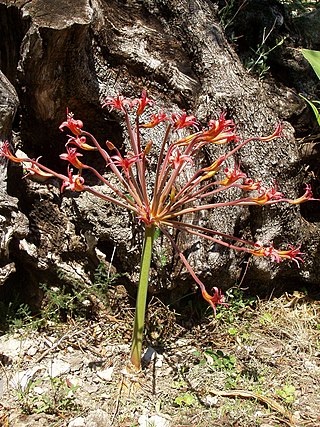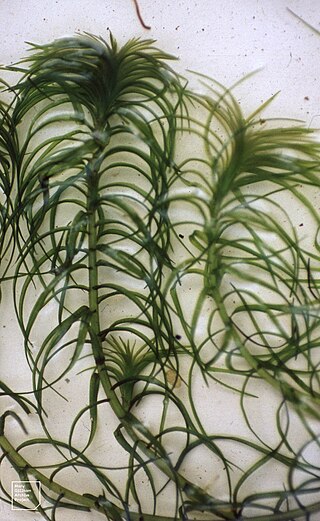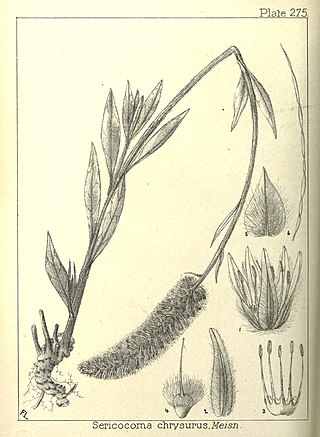
KwaZulu-Natal is a province of South Africa that was created in 1994 when the government merged the Zulu bantustan of KwaZulu and Natal Province.

Veld, also spelled veldt, is a type of wide open rural landscape in Southern Africa. Particularly, it is a flat area covered in grass or low scrub, especially in the countries of South Africa, Lesotho, Eswatini, Zimbabwe and Botswana. A certain sub-tropical woodland ecoregion of Southern Africa has been officially defined as the Bushveld by the World Wide Fund for Nature. Trees are not abundant—frost, fire and grazing animals allow grass to grow, but prevent the build-up of dense foliage.

Tulbaghia is a genus of monocotyledonous herbaceous perennial bulbs native to Africa, belonging to the amaryllis family. It is one of only two known genera in the society garlic tribe within the onion subfamily. The genus was named for Ryk Tulbagh (1699–1771), one time governor of The Cape of Good Hope.

Kniphofia is a genus of perennial flowering plants in the family Asphodelaceae, first described as a genus in 1794. All species of Kniphofia are native to Africa. Common names include tritoma, red hot poker, torch lily and poker plant.

Clutia is a plant genus of the family Peraceae. It is native to sub-Saharan Africa and to the Arabian Peninsula.

Brunsvigia is a genus of African flowering plants in the family Amaryllidaceae, subfamily Amaryllidoideae. It contains about 20 species native to southeastern and southern Africa from Tanzania to the Cape Provinces of South Africa.

Hypoxis villosa is a plant species in the Hypoxidaceae, formerly included in the Liliaceae or Amaryllidaceae. It is native to southern Africa – South Africa, Lesotho, and Eswatini.

Schizochilus is a genus of flowering plants from the orchid family, Orchidaceae. It is native to southern and eastern Africa.

Aeropetes is a monotypic butterfly genus in the family Nymphalidae. Its only species, Aeropetes tulbaghia, is commonly known as the Table Mountain beauty or mountain pride. It is native to southern Africa, where it occurs in South Africa, Lesotho, Eswatini and Zimbabwe.

Lagarosiphon is a genus of aquatic plants described as a genus in 1841. It is native to Africa and Madagascar. It is dioecious, with male and female flowers produced on separate plants.

Tulbaghia violacea, commonly known as society garlic, pink agapanthus, wild garlic, sweet garlic, spring bulbs, or spring flowers, is a species of flowering plant in the family Amaryllidaceae, indigenous to southern Africa, and reportedly naturalized in Tanzania and Mexico.

Eucomis pallidiflora, the giant pineapple lily, is a bulbous species of flowering plant in the family Asparagaceae, subfamily Scilloideae, native to southern Africa. The white to green flowers appear in summer and are arranged in a spike (raceme), topped by a "head" of green leaflike bracts. Some forms reach almost 2 m when in flower. The species is cultivated as an ornamental plant, although it is not hardy in areas where severe frosts occur.

Bonatea is a genus of orchids native to tropical and southern Africa, with one species extending into Yemen and Saudi Arabia.

Syncolostemon (sagebushes) is a genus of plants in the family Lamiaceae, first described in 1838. It is native primarily to South Africa, with some species in other parts of sub-Saharan Africa, plus one species in India.
- Syncolostemon albiflorus(N.E.Br.) D.F.Otieno - Transvaal, Eswatini
- Syncolostemon argenteusN.E.Br. - KwaZulu-Natal
- Syncolostemon bolusii(N.E.Br.) D.F.Otieno - KwaZulu-Natal
- Syncolostemon bracteosus(Benth.) D.F.Otieno - widespread across much of sub-Saharan Africa
- Syncolostemon canescens(Gürke) D.F.Otieno - Angola, Botswana, Zimbabwe, Eswatini, South Africa
- Syncolostemon cinereum(Codd) D.F.Otieno & Retief - South Africa
- Syncolostemon comosus(Wight ex Benth.) D.F.Otieno - southern India
- Syncolostemon comptoniiCodd - Eswatini
- Syncolostemon concinnusN.E.Br. - Eswatini, South Africa
- Syncolostemon densiflorusBenth. - South Africa
- Syncolostemon elliottii(Baker) D.F.Otieno - Zimbabwe, Botswana, Transvaal
- Syncolostemon eriocephalusVerd. - Northern Province of South Africa
- Syncolostemon flabellifolius(S.Moore) A.J.Paton - Chimanimani Mountains of Mozambique + Zimbabwe
- Syncolostemon floccosus(Launert) D.F.Otieno - Namibia
- Syncolostemon foliosus(S.Moore) D.F.Otieno - Eswatini, South Africa
- Syncolostemon gerrardii(N.E.Br.) D.F.Otieno - South Africa
- Syncolostemon incanus(Codd) D.F.Otieno - Northern Province of South Africa
- Syncolostemon latidens(N.E.Br.) Codd - KwaZulu-Natal
- Syncolostemon linearis(Benth.) D.F.Otieno - Zimbabwe
- Syncolostemon macranthus(Gürke) Ashby - Drakensberg Mountains in South Africa
- Syncolostemon macrophyllusGürke - South Africa
- Syncolostemon madagascariensis(A.J.Paton & Hedge) D.F.Otieno - Madagascar
- Syncolostemon modestus(Codd) D.F.Otieno - Eswatini, South Africa
- Syncolostemon namapaensisD.F.Otieno - Mozambique, Tanzania
- Syncolostemon obermeyerae(M.Ashby) D.F.Otieno - Northern Province of South Africa
- Syncolostemon oritrephes(Wild) D.F.Otieno - Chimanimani Mountains of Mozambique + Zimbabwe
- Syncolostemon ornatus(S.Moore) D.F.Otieno - Chimanimani Mountains of Zimbabwe
- Syncolostemon parviflorusE.Mey. ex Benth. - Eswatini, South Africa
- Syncolostemon parvifolius(Codd) D.F.Otieno - Northern Province of South Africa
- Syncolostemon persimilis(N.E.Br.) D.F.Otieno - Northern Province of South Africa
- Syncolostemon petiolatus(Ashby) D.F.Otieno - Eswatini, South Africa, Mozambique
- Syncolostemon pretoriae(Gürke) D.F.Otieno - Eswatini, South Africa
- Syncolostemon punctatus(Codd) D.F.Otieno - Northern Province of South Africa
- Syncolostemon ramosus(Codd) D.F.Otieno - KwaZulu-Natal
- Syncolostemon ramulosusE.Mey. ex Benth. - KwaZulu-Natal, Cape Province
- Syncolostemon rehmannii(Gürke) D.F.Otieno - Northern Province of South Africa
- Syncolostemon rotundifoliusE.Mey. ex Benth. - KwaZulu-Natal, Cape Province
- Syncolostemon rugosifolius(M.Ashby) D.F.Otieno - Northern Province of South Africa
- Syncolostemon stalmansii(A.J.Paton & K.Balkwill) D.F.Otieno - Mpumalanga, Eswatini
- Syncolostemon stenophyllus(Gürke) D.F.Otieno - KwaZulu-Natal, Cape Province
- Syncolostemon subvelutinus(Gürke) D.F.Otieno - Northern Province of South Africa
- Syncolostemon teucriifolius(Hochst.) D.F.Otieno - Mozambique, Zimbabwe, South Africa
- Syncolostemon thorncroftii(N.E.Br.) D.F.Otieno - Northern Province of South Africa
- Syncolostemon transvaalensis(Schltr.) D.F.Otieno - Northern Province of South Africa
- Syncolostemon welwitschii(Rolfe) D.F.Otieno - Nigeria, Cameroon, Central African Republic, Zaire, Tanzania, Zambia, Angola

Stenostelma is a genus of plants in the family Apocynaceae, first described as a genus in 1894. It is native to southern Africa, ranging from Mozambique, Zambia, and Namibia to South Africa.

Albuca shawii is a species of bulbous plant from southern Africa. It flowers in the summer and has yellow flowers on stems to about 30 cm high.

Eucomis schijffii is a bulbous species of flowering plant in the family Asparagaceae, subfamily Scilloideae, native to the Cape Provinces, KwaZulu-Natal and Lesotho. It was first described by William Frederick Reyneke in 1976. The reddish purple flowers appear in summer and are arranged in a spike (raceme), topped by a "head" of green leaflike bracts. It is cultivated as an ornamental plant and can be grown successfully outside where frosts are not too severe. The smallest of the species of Eucomis, it is particularly suited to being grown in rock gardens or containers.
Melhania forbesii is a plant in the mallow family Malvaceae, native to southern Africa. It is named for the English naturalist and plant collector John Forbes.

Kyphocarpa is a genus of flowering plants belonging to the family Amaranthaceae. It is in the Amaranthoideae subfamily.
Tulbaghia natalensis, called pink wild garlic and sweet wild garlic, is a species of flowering plant in the family Amaryllidaceae, native to the Cape Provinces and KwaZulu-Natal in South Africa. It has gained the Royal Horticultural Society's Award of Garden Merit as an ornamental.



















